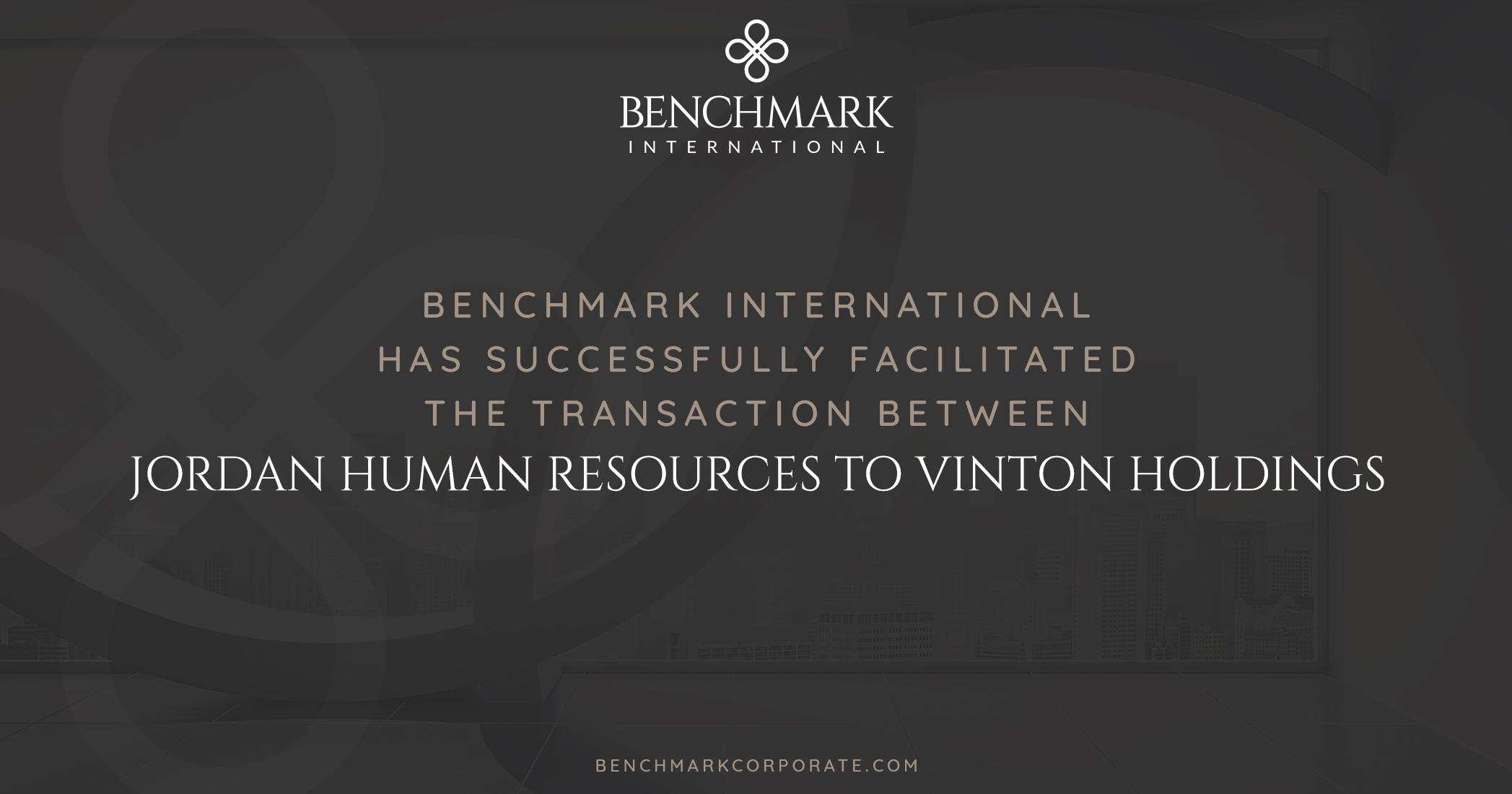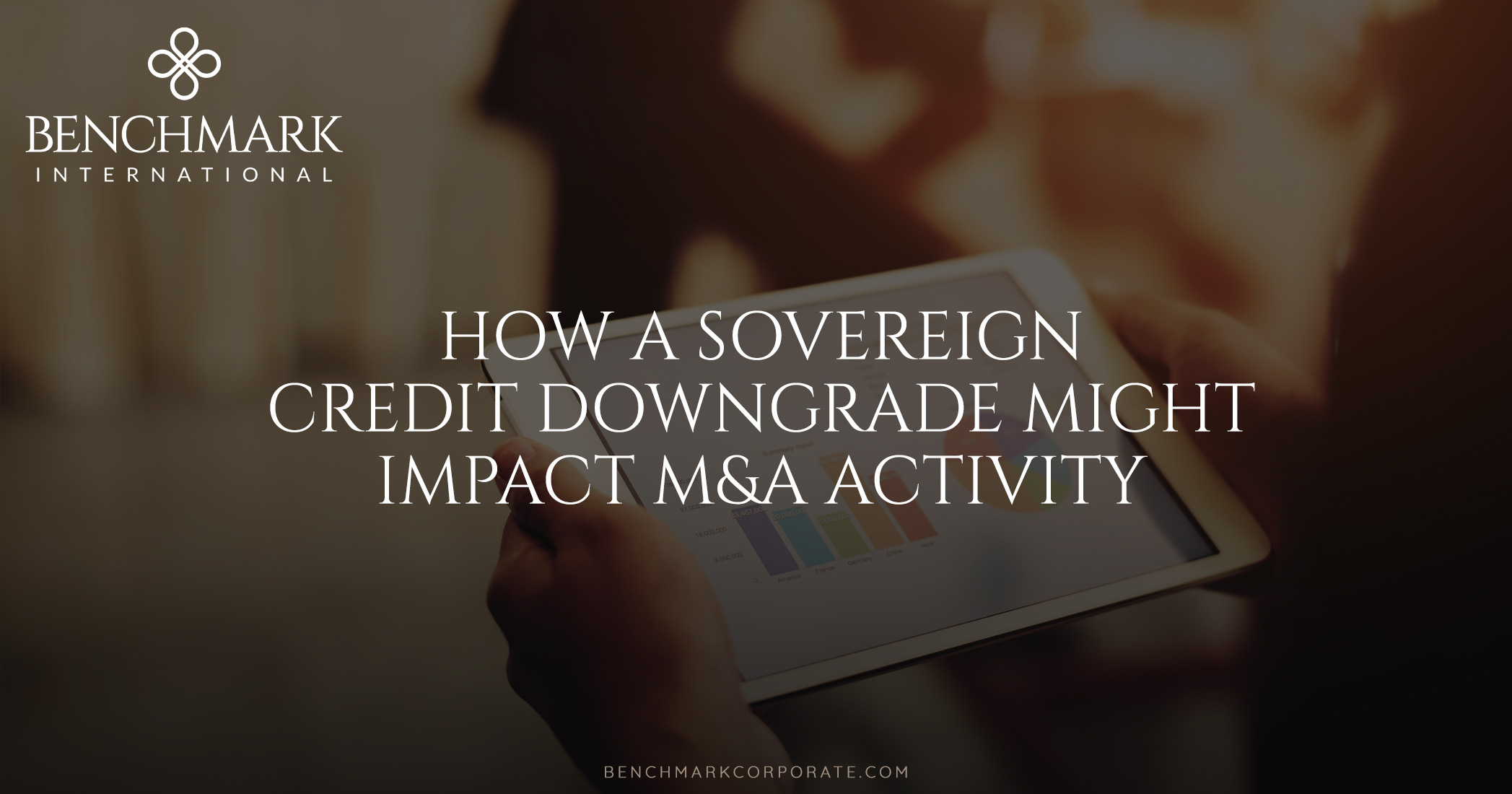Benchmark International has been named the International Mid-market Corporate Finance Advisory of the Year by the Gamechangers™ ACQ Global Awards.
Gamechangers™ is a leading corporate news publication, serving the finance sector since 2003. They provide a global audience of more than 245,000 senior executive-level subscribers with valuable information.
The Gamechangers™ Global Awards are the most extensive program of their kind in the market, celebrating achievement, innovation, and brilliance in the industry. They have a legitimately independent nomination process, and the winners are chosen by the industry itself. They rely on reader insight and experience for the nominations and look for exemplary businesses that are the benchmark of achievement in their field on a global level. Firms of all sizes are recognized, and the awards represent an endorsement of outstanding work. The awards are the only industry honors awarded purely on the basis of voter participation.
Gregory Jackson, CEO of Benchmark International, said, “Our incredibly talented team is behind our success. Everyone is so focused on doing the best for our clients—it’s actually personal for them. They see each deal from the perspective of the business owner and really know what it’s like to be in their shoes. Our compassion coupled with our expertise gives us an edge all around the world.”
Archives
Benchmark International Named International Mid-market Corporate Finance Advisory Of The Year
M&A In The Global Health and Life Insurance Industry
Common drivers of mergers and acquisitions in the global health and life insurance industry include the entry into new markets, access to new technologies, valuation trends, and reaction to regulatory changes. With growth strategies leading the charge, market expansion is often made possible through the acquisition of target companies that optimize product portfolios and customer bases, especially those that provide relatively easy yet quite valuable add-on opportunities, as organic growth does not come easily in the insurance space.
READ MORE >>Share this:
The Digital Marketing Industry and M&A
The trillion dollar advertising space is a rapidly changing industry with most of the action happening on the digital marketing side. As the world’s digital advertising revenues increase, there is a global demand for more online content. Lead generation, advertising, search engine optimization, and affiliate partnerships are major drivers of income in the 21st century marketing industry. This demand drives up the value of content-related businesses and digital marketing agencies in an era where everyone is glued to their connected devices. All of this screen time has caused traditional advertisers (print, TV, outdoor, radio) to shift their largest spends to digital marketing tactics and mobile internet advertising, even outspending television ads.
Worldwide digital advertising spending is predicted to reach $517 billion by the end of the year 2023.
The robust growth, sheer size, and high fragmentation of the digital marketing sector has led to healthy mergers and acquisitions activity involving digital agencies. Everyone from traditional advertising agencies to private equity investors is seeking target companies that offer growth benefits.
The establishment of digital capabilities and relationships has become a major priority for traditional ad agencies and their large holding companies as they look to grow their digital revenue and expand their portfolios. As conventional media continues to be displaced by digital marketing, the percentage of media spend on digital marketing on behalf of traditional ad agencies will continue to grow.
Evolving Technologies
In the digital marketing industry, there is also growing popularity of technologies that offer individualized features and more in-depth experiences. Brands are being pushed to invest and acquire these types of technologies while post-sales marketing has become a more prominent element along the customer journey.
- The use of chatbots and personalized messaging is enhancing customer experiences.
- Audio queries made possible by smart devices and digital assistants are driving voice search.
- Online video advertising is a quickly growing segment.
- Artificial intelligence analytics are helping to better target marketing strategies based off of real-time data. This data leads to meaningful insights that are used to improve customer interaction, and optimize media budgets and marketing strategies.
- Social search is changing e-commerce and vehicles for product reviews and recommendations.
This industry is sure to see more and more future technologies that have yet to be developed, continuing to drive rapid change and growth, and create opportunities for M&A.
Large User Platforms
Giant platform companies such as Google and Facebook provide free digital products and services but are still able to profit because they reach such massive audiences.
The larger the platform, the more consumer data is collected. The more a consumer uses the platform, the more information is gleaned about them. And with more data, the platform can better tailor the content consumers see, and keep them on the platform longer. This results in improved customer experiences and more advertising capacity, which means better understanding of consumers, heightened influence, and more revenue from targeted advertising.
Affiliate Partnerships
Affiliate partnerships use affiliate websites to promote products or services that belong to another company. The valuation of an affiliate website depends on the specific terms of the affiliate program. These factors include longevity, product category and seasonality, commission tiers, high caliber content, and the link portfolio. Websites that fulfill these attributes often have the better earnings, margins and lifecycle, which are attractive to investors. For valuation purposes, advertising agencies are similar to affiliate businesses because they are dependent upon content and end-user action to produce revenue.
These types of partnerships that monetize content also apply to offline businesses that need new and better ways to generate access to audiences. Investors also tend to be drawn to this segment based on existing relationships that can be used to an advantage.
Exit Opportunities
Some digital marketing agencies are being established with the goal of selling in mind. There are extremely low entry barriers when it comes to creating a digital marketing firm, but there are also limited benefits to growth. Some brands do not wish to work with a huge firm. And low employee tenure means lower retained corporate knowledge in an industry where talent retention is already incredibly challenging.
An agency with strong historical growth and projected growth of more than 20% can lead to strong multiples. The purchase of smaller agencies offers opportunities for growth for the large advertising agency groups and an easy way to cash out for the leadership of the smaller agencies.
Contact Us
Please feel free to contact our M&A advisors at Benchmark International to discuss your next move. Our industry expertise and global connections are true game changers when it comes to selling or growing a company, and forming an exit plan.
READ MORE >>Share this:
The Global Packaging Industry and M&A
Manufacturers in the global packaging industry produce items such as bags, films, air pillows, bubble cushioning, heavy plastics, aluminum foil, paperboard, and corrugated materials.
In a segment that is greatly influenced by transportation and logistics costs, strategic buyers look for options that offer attractive margin profiles, cost-savings manufacturing advantages, shareholder growth options, and deals that broaden industry presence and consolidate business lines. Private equity buyers are inclined to focus on niche opportunities that leverage unique and proprietary capabilities and offer strong returns.
In this particular sector, lenders tend to show willingness to finance deals among packaging companies, which boosts healthy valuations. This is because packaging manufacturers are able to generate strong cash flow and are not overly vulnerable to economic downturns.
Growth from E-commerce
As long as e-commerce continues to thrive and the world demands sustainable and cost-efficient packaging solutions, the demand for packaging products will persist, driving mergers and acquisitions activity in this highly fragmented industry.
Protective packaging solutions are naturally of significant interest to e-commerce companies, as is machinery that uses automation to improve packaging processes. There is a demand for packaging companies that can offer innovative and attractive packing solutions that are protective but lightweight and focused on reducing package footprint size.
Fast-Moving Consumer Goods (FMCG)
The FMCG segment involves high-volume, low-cost products that move quickly off the shelves of stores, such as paper products, cosmetics, medicines, detergents, and plastic goods. Packaging is top priority in the FMCG market because of how it directly affects brand positioning, differentiation, and high visibility through the use of graphics and product information. It plays a major role in consumers’ purchase decisions in a very competitive environment.
FMCG packaging makes up a large share of the costs involved in product manufacturing. Companies must look to innovation in packaging to reduce operational costs.
Increasing populations, technological advancements, and a demand for eco-friendly packaging are all key drivers of growth in the FMCG sector. Food and beverage is the largest market for investment from packaging companies.
On the supply side, the FMCG packaging market is highly fragmented with fewer companies having a substantial share in the overall market, leading to fewer barriers to entry. Additionally, the challenges for growth in this sector include issues surrounding skilled labor, equipment and machinery.
Healthcare and Pharmaceuticals
Medical plastics are a major driver of high valuations in the packaging sector. The healthcare industry is subject to significant regulatory and technical requirements and there is a need for companies that can fulfill their specific and complex packaging needs, which include thermoforming and injection molding techniques. The injection-molding sector is especially fragmented and highly competitive with steadily growing revenues and opportunities for consolidation.
There is also a demand for smart packaging technologies that help to combat the counterfeiting of medicines.
Packaging companies that serve medical device and component companies tend to enjoy stronger customer relationships, steadier revenue, better pricing power, and higher valuations. M&A activity in this area is highly focused on technology and expansion of capabilities.
Sustainable Solutions
Sustainability is an important factor in the packaging industry at every step of the value chain, as consumers and regulators apply pressure regarding environmental impacts of packaging applications. In addition to functionality and convenience, it is a key criterion in purchasing decisions. This demand for novel solutions and green technologies creates a noteworthy opportunity for industry players.
Plastics are cost-efficient, convenient, and have useful characteristics in packaging, so their use remains in demand. However, there is a sweeping campaign to reduce the use of plastic in packaging materials.
Airless packaging systems are a growing market. They are designed to limit waste and contamination while improving product shelf life. These packaging products include bags, pouches, bottles, jars, and tubes.
As there is a growing need for packaging companies to lessen the environmental effects of their products, those that stay ahead of the curve by incorporating these solutions will benefit from substantial growth opportunities and will draw plenty of attention for M&A activity.
Contact Us
If you feel the time has come to enter into a merger or acquisition, reach out to our specialists at Benchmark International to get the ball rolling. Our customized solutions, global buyer network, and proprietary methodologies have the power to execute deals that are designed to always exceed seller expectations.
READ MORE >>Share this:
M&A And The Construction Materials Industry
The construction materials industry is comprised of suppliers of the raw materials used by builders in both commercial and residential construction. This wide array of materials are both natural and man-made:
- Limestone, granite, sand, clay, gypsum
- Cement, gravel and crushed stone
- Bricks, mortar, concrete, asphalt, and other materials
- Wood, timber, plywood and veneer
- Glass, plastics, ceramics and foam
- Steel, copper and aluminum
Mergers and acquisitions in this space are highly dependent on market predictability. This particular sector is susceptible to various factors that dictate its economic health and prosperity. These include:
- GDP growth
- Trade and tariff issues
- Interest rates
- The strength of the housing markets
- Labor shortages
- The cyclical demand imposed by seasonality and the weather
The top three global markets that lead the way and have the most potential for growth in the building materials industry are Asia-Pacific, the Middle East and Africa, and the United States. Population growth and sprawling urbanization increase the demand for construction, and therefore increases the demand for construction materials.
Market Overview
The construction materials sector is quite fragmented with relatively low concentrations of market share, low barriers to entry, and high availability of alternate manufacturing capabilities (such as in hardware and cabinetry). As industry leaders typically concentrate on high-demand markets, access to substitutes creates opportunities for smaller players, allowing them to serve niche and lower-demand markets.
In contrast, some sub-sectors are more integrated because they depend greatly on one or a few key materials, so industry leaders often occupy a major portion of the market (such as insulation or countertops).
Key Drivers of M&A
In the construction materials industry, key drivers for M&A activity include:
- Large project backlogs with healthy margins
- A need for revenue growth in a sector where organic growth is challenging to achieve
- The availability of low-cost debt financing
- Improved supply channels
- The level of demand for housing
Strategic buyers seek acquisitions in this space in order to:
- Strengthen their market positions by adding competitors and niche companies
- Develop a technological advantage and build a stronger brand
- Expand globally and take advantage of established distribution networks
- Fuel growth and improve margins through economies of scale
- Integrate customer bases and create barriers to entry
An Untapped Opportunity
The global construction materials industry is one of the least digitized industries in the modern world. It already faces plenty of inherent challenges, and paperwork slows down processes. New operational tools can offer better ways to evaluate performance and allow real-time views into inventory, transit, and fleet operations.
There is an opportunity for all stakeholders to benefit substantially from digitization and automation within this particular industry. These improvements include better productivity, greater cost savings, enhanced customer service, and a powerful competitive edge. Adaptation of new technologies in this industry can also unlock new opportunities for M&A transactions as companies look for easier paths to accessing innovation.
The Advent of New Materials
Technology is changing more than the way construction material companies do business. It is also changing the materials themselves. As the world looks to more sustainable and environmentally friendly construction projects, builders will look to new materials, and the suppliers of construction materials must be prepared to keep pace. New innovations in materials include:
- The recycling of plastic to build roads
- Carbon dioxide-infused concrete to improve durability
- Self-healing concrete
- 3D-printed materials
- Translucent wood as a low cost resource
- Hydroceramics (temperature-reducing bricks)
- Light-generating cement
- Aerographite
- Modular bamboo
- Aluminum foam
- Bricks that absorb pollution and filter air
- Algae-infused energy-producing wall panels
The construction industry serves almost every other industry, and is the single largest worldwide consumer of resources and raw materials. It is also a massive generator of waste due to demolition. There can be great value in exploring changes in the way buildings are constructed and the materials that are used. Even small changes have the ability to produce substantial benefits for society simply because of the sheer magnitude of the industry. Project owners and investors can play an important part in propelling the industry forward.
Contact Us
At Benchmark International, our M&A specialists are on standby, just waiting for you to enlist their partnership in selling your business or growing your company. Let us put our exceptional strategies, proprietary technologies and global connections to work for you.
READ MORE >>Share this:
M&A In The Global Medical Services Industry
Globalization of healthcare contributes to a continually developing global medical services industry that encompasses hospital, physician and clinical, nursing and continuing care facilities, home healthcare, surgical facilities, emergency services, laboratories and other providers.
Value-based Care
An industry that was once about volume-based care has strategically shifted to value-based care. Because this requires improvements in facility efficiencies and quality, it also calls for more specialized external service providers. One tactic that medical services companies are using to gain competitive advantage is to keep their core caregiver and third-party caregiver groups under the same roof. As medical services must now deliver on value-based care, there is an increased need for integration of care and management of financial constraints.
Workforce Demand
As populations increase, especially aging populations, and chronic diseases remain prevalent, the demand for medical services increases, and so does the demand for specialized medical caregivers.
By the year 2030, it is estimated that the global demand for health workers will reach 80 million workers, while the supply of health workers is only expected to reach 65 million over the same period. This will result in a worldwide shortage of 15 million health workers.
Regulatory Factors
When regulatory burdens on healthcare companies are reduced, technological advancement escalates, creating opportunities for medical technology companies including mobile and wireless providers. Also, advancements in surgical techniques result in less invasive treatments and shorter recovery times, altering the traditional hospital model. Additionally, third-party lab providers and research companies grow in demand along with the need for more complex clinical tests and services.
M&A Due Diligence
Mergers and acquisitions in the medical services industry require especially savvy due diligence in order to obtain a completely accurate assessment and valuation. Deals can be particularly complicated between hospitals and health systems.
As a seller, it can be extremely important to have sell-side due diligence conducted. Getting ahead in the process months in advance can be well worth the costs. When it comes to the medical services industry, billing and coding issues can trigger major delays in any M&A transaction.
Other benefits of sell-side due diligence include:
- Enhanced credibility and positive reputation of the seller on the market
- The increased possibility of higher bids
- Adequate preparation for management and employees so that there is minimal disruption in workplace operations
- The potential of a shorter due diligence cycle on the buyer’s side
- A decrease in the chances of surprises that can derail a deal, which can increase the likelihood of the transaction being a successful one
Medical Services M&A Drivers
Among the key drivers of M&A activity in the global medical services industry, the top reasons include:
- The goal of increased market share to broaden networks and patient access
- Improved integration across the continuum of care
- Keeping pace with increasing prevalence of consumerism, which includes more convenient, non-traditional care settings
- Gaining access to capital for investment in staff, new technologies, medical equipment, and improved operations
- A way to improve efficiencies and enhance patient satisfaction
- Reaction to rising consolidation among insurance payers
- A growing need for alternative payment models, which reimburse providers based on value rather than volume of services
Traits of High-value Targets
In this sector, the attributes of high-value M&A transactions can vary greatly, however certain characteristics can be found to be consistent across most successful deals:
- A defined operating model with strategic vision and revenue-growth and cost-reduction strategies
- Transparency in communications regarding culture and organizational goals
- Focused integration planning that aligns with the deal’s rationale
M&A in Diagnostics
Diagnostics present unique circumstances for M&A activity apart from the medical services industry. Clinical laboratories in the medical services industry vary in size, business model, areas of concentration, R&D capabilities, as well as in their relationships with providers and payers. With countless labs in operation, acquiring the right one can be challenging. Large public labs tend to focus on deal volume, while other buyers are interested in the laboratory testing market, and private equity leans towards companies with attractive cash flow yields. In many cases, because diagnostic manufacturers, life-science companies, and big pharma all need access to patient and pathology samples for research and development, labs are strategically acquired by non-laboratory healthcare companies.
Contact Us
If you are looking for exit and growth strategies, Benchmark International offers unique ways to identify the perfect buyer, take your company to the next level, and create dream exits. We look forward to working with you.
READ MORE >>Share this:
Benchmark International volunteered with Second Harvest Food Bank of Tennessee
Benchmark International office in Nashville, Tennessee took part in the Second Harvest Food Bank donation efforts. This organization gives back to the communities of Tennessee through donations and volunteers committed to providing nutritious meals to those in need.
Managing Partner, Tyrus O’Neill, worked with his team to host this event. Half of the team participated on Thursday October 17, 2019, and the other half of the team will participate this Thursday October 24, 2019. He stated that he is glad his team has the opportunity to participate in a good cause for the community.
“The impact of hunger in the local community is an often-overlooked issue. Malnutrition and hunger, especially in children, can cause lasting developmental and health issues,” O’Neill said. “Local organizations like the Second Harvest Food Bank of Middle Tennessee do a great service to the community and is an organization we proudly work with. The Nashville office of Benchmark International looks forward to the continued efforts of Second Harvest Food Bank and the role we can play in helping the local community thrive.”
Second Harvest Food Bank of Middle Tennessee opened its doors in 1978 with commitment from several community leaders. The purpose of the organization was to provide a central distribution center for companies, groups, and individuals who wished to help provide food for hungry people in Middle Tennessee. Their mission is to feed hungry people and work to solve hunger issues in their community.
Since its inception, Second Harvest Food Bank of Tennessee has grown to be one of the largest and most comprehensive of more than 200 food banks and food distribution centers nationwide. In 2018 alone, Second Harvest distributed more than 30 million pounds of food to more than 460 Partner Agencies, providing more than 28 million meals to hungry children, families, and seniors throughout their 46-county service area.
This is a tangible way for the Benchmark International team to give back to the community and make an immediate impact in the lives of children in need. The team is preparing a total of 6,000 sack lunches for children, in afterschool programs, who don’t always know where their next meal will come from.
Administrator Deborah McManman organized the event for the Tennessee office. She stated, “I’ve heard so many amazing stories about the work done at Second Harvest Food Bank I knew it would be a great place for our office to volunteer,”
This experience allows everyone to see how just a few hours can make a real difference in the community. The team bagged food, and it’s a simple task, but it makes a difference in the lives of children. It gives them the ability to go to sleep on a full stomach and go to class with more energy. The Tennessee team looks forward to taking part in this event again in the future.
Benchmark International is proud to be able to participate in such worthy causes as this of Second Harvest Food Bank of Tennessee. Giving back to our local communities in any way we can is a central part of our work culture. Thank you to all the team members who participated.
READ MORE >>Share this:
Benchmark International Successfully Facilitated the Transaction of Jordan Human Resources To Vinton Holdings
Jordan HR is a niche human resources firm that specialises in the recruitment of medical practitioners, with a keen focus on Locum Pharmacists.
READ MORE >>Share this:
Why You Shouldn’t Wait For The New Year To Sell Your Company
A new year always conjures up the feeling that it’s a clean slate, so that may seem like a good time to take your business to market. And, yes, timing is everything, but waiting for the new year could mean that you miss out on the opportunity to get the maximum value for your business.
Get Ahead of Economic Uncertainties
No one can say for sure what the state of the global economy will be next year. But we do know what it is NOW. These are certainties that we know, understand, and can work within. We know what M&A strategies can be advantageous today based on the level of:
- Buyer demand
- Bank generosity
- Current valuations
- Tax breaks
- Interest rates
- Retiring competitors
- Inflation
- Political unrest
It is not uncommon for business owners to want to postpone a sale with hopes that they can sell at a higher price in the future. This can be a dire mistake.
Waiting too long could mean that you end up trying to sell during a recession, a down cycle, or under other unfavorable circumstances that result in you not getting all that your company is truly worth. It can also mean that if you miss out on your ideal window of opportunity, you may have to wait five to seven years for such an opportunity to arise again.
Take Advantage of a Seller’s Market
What may be a seller’s market today, can just as easily become a buyer’s market tomorrow. If you decide to wait, you could end up losing your upper hand as a seller. There are millions of business owners that are approaching retirement age and if there is an influx of these sellers onto the market, it can result in increased competition and buyers will enjoy having their pick of the litter. That also means lower valuations for your company. You can easily get out in front of this scenario by not hesitating to start the process.
According to the Pew Research Center, 10,000 Baby Boomers will celebrate their 65th birthday every day through the year 2030.
Act Early for a Patient Process
Patience is a virtue, especially when it comes to selling a company. Ironically, getting into the sale process sooner rather than later will afford you the ability to be patient through the process. If you wait too long and end up in a situation where you are panicking to sell your company, buyers will sense your desperation and will try to low-ball you on a deal. By demonstrating to buyers that you have been carefully considering and planning for this, rather than appearing to just “want out” without an exit or succession plan, it will likely increase your sale price.
Test the Market
Maybe you are feeling too uncertain about selling now. Keep in mind that you can always test the market. Prepare your company for sale, put it out there, and see what kind of offers you get. You might find that there is interest in your company that you were not aware of, and eager buyers might come to the surface, surprising you with offers that are hard to turn down. In the case that the offers are lower than what you were hoping for, you can simply take the company of the market for the time being and wait for a better time.
Ready to Talk?
The process of selling a business can take several months. Even if you are simply considering a sale, reach out to one of our M&A advisors at Benchmark International to start the conversation. We can help you get a better understanding of the market timing, if you feel that you are ready to sell, and what exit strategy is right for you. We also understand that you have worked hard to build your business, and parting with it is going to be an emotional process. That is why we always work in the seller’s best interest, working relentlessly to arrange a deal that is the absolute very best for you and your family and with which you feel truly comfortable.
READ MORE >>Share this:
Benchmark International (South Africa) is proud to be shortlisted for the annual Africa Global Funds Awards
Benchmark International (South Africa) is proud to be recognised and shortlisted in the category of Best Independent Advisory Firm alongside some of South Africa’s most recognised corporate finance brands.
The Awards were created to honour and generate both industry and public recognition of the outstanding efforts and accomplishments of Service Providers covering Africa.
The 2019 awards shortlist was announced in mid-September and the black-tie event and ceremony will be hosted on October 24th at the Radisson Blu Sandton, Johannesburg, South Africa.
Benchmark International’s nomination was motivated by the consistent year on year growth in transaction activity and success achieved in transactions across the spectrum of M&A and corporate finance disciplines.
About Benchmark International:
Benchmark International’s global offices provide business owners in the middle market and lower middle market with creative, value-maximising solutions for growing and exiting their businesses. To date, Benchmark International has handled engagements in excess of $6B across various industries worldwide. With decades of global M&A experience, Benchmark International’s deal teams, working from 12 offices across the world, have assisted hundreds of owners with achieving their personal objectives and ensuring the continued growth of their businesses.
READ MORE >>Share this:
The IT Services Industry and M&A
Information Technology (IT) services encapsulate maintenance and security with regard toonsite and remote tech support,infrastructure, computers, servers, networks, workstations,firewalls, cloud services, web development, systems integration, telecom, patch management, software updates, big data, and virus and malware prevention.
READ MORE >>Share this:
The Facility Services Industry and M&A
Facility services providers deliver a wide array of outsourced support functions to commercial, industrial, multifamily and residential facilities, including:
- Janitorial, sanitation, and general maintenance and repair
- Mechanical, electrical, HVAC and plumbing
- Security
- Fire and safety
- Disaster recovery
- Sign and lighting
- Landscaping
- Parking lot maintenance, lighting, and snow management
- Pest control
- Laundry
Driving the Demand
This several-hundred-billion-dollar global market is largely driven by commercial construction projects, a focus on reducing building operating costs, and outsourced facility management operations.
Heightened commercial construction activity galvanizes the necessity for facility support services because commercial premises require constant upkeep, repair, surveillance and cleaning. Increases in these construction and renovation projects are stimulated by:
- Strong levels of consumer and business confidence
- The need for rebuilding following natural disasters
- Increased corporate investment in capital expenditures
- Low interest rates
Any sustained action within these types of projects creates a favorable M&A environment for facility services providers.
Regulatory organizations also prompt the need for outsourcing of facility support services, as companies must deal with pressure regarding workplace health and safety protections and environmental regulations. These particular liabilities are why some facility services providers also offer value-added services such as risk management and labor law supervision.
The facility services sector has a history of drawing the attention of private equity, as investors seek asset-light business models with recurring revenue and add-on acquisitions. Additionally, large public companies continue to drive consolidation in their end markets. Because this industry is so fragmented, there is ample opportunity for strategic and cross-border acquisitions that lead to expanded geographic presences and broader product offerings.
Serial Acquirers
In this particular commercial services industry, there has been a tendency for certain acquirers to buy up several companies over the course of a shorter timeframe, most often in the testing, inspection, and certification segment. It has not been uncommon for one company to acquire more than five companies within one year. These types of serial buyers have developed a very streamlined approach to the M&A process, from evaluation to integration. Because of this, investors see these strategies as a steady source of growth, prompting companies to actively seek numerous incremental acquisitions.
Due Diligence and Acquisition Platforms
Because the M&A environment in the facility services market is very competitive and there is a prevalence of serial acquisitions, up-front due diligence is key to seeing a deal through to success. Aggressive buyers are able to gain an edge by conducting more of their due diligence prior to the formal launch of the deal process. This also aids in speeding up the endeavor.
An important element of the due diligence process for serious buyers in the facility services industry is the viability of the target company to serve as a platform for subsequent acquisitions. Many buyers view this ability as a mandatory feature of a deal. The prospect of future add-on acquisitions allows buyers to lower the overall acquisition multiple and get a better return on capital. This makes it a critical part of the due diligence process.
Facility Technologies
As the Internet of Things prompts transformation within all industries, the facility services sector has seen a shift towards software-based technologies.
- Digital facility maintenance platforms have improved the efficiency of processing work orders and enable more effective cross-organizational communication.
- Innovative technologies are being implemented to reduce maintenance costs, avoid expensive failures, and extend the life of equipment.
- The use of data systems enables providers to help clients reduce costs and energy consumption.
- Online systems make labor markets more flexible, improving productivity through on-demand workforces.
- Digitization enhances compliance with regulations regarding safety, zoning codes and financial transparency.
As interest in facility software platforms and support solutions continues to grow, so does investor interest.
Contact Us
Is your company ready for the next step? Set up a chat with one of our M&A experts at Benchmark International and we can discuss growth strategies, exit planning, or the partial or complete sale of your business. Our exclusive processes and global connections make our approach to M&A unique, which is why our clients love working with us.
READ MORE >>Share this:
Benchmark International’s Nick Hulme Named Most Active Financial Advisor
Benchmark International’s Nick Hulme was named Most Active Financial Advisor by Pro-Manchester Annual Corporate Finance Review.
READ MORE >>Share this:
Webinar: How To Navigate A Deal With Private Equity Funds And Be Successful
For many sellers, the notion of selling the business they built from the ground up to a private equity fund is unimaginable. Many have heard horror stories from their friends, perhaps read books about the pitfalls of private equity buyers, and may even have some personal experiences. While dealing with private equity funds can be problematic for sellers, they often also are the best, most logical buyer. They are well-funded, so there is little risk the deal will fall through because of the inability to fund. Also, today’s private equity funds generally will leave their portfolio companies to operate free of interference, only offering support, guidance, and growth capital. However, if unrepresented by a capable M&A advisor, sellers can run into many problems in the midst of a transaction with a private equity fund.
What are these pitfalls? Here are a few:
- There’s a pronounced gap between what is expected from the fund as it relates to data and what is readily accessible from the seller. How do you bridge that gap?
- Be aware that Private Equity math is very complicated. Will they bring leverage to the transaction? Where will that debt sit? Will it appropriately dilute their equity? What is a Net Working Capital Peg? How is it calculated? How can buyers use it to erode deal value?
- How do you know that the deal being offered is competitive with what is out there in the market? PE Funds buy companies for a living, so they are very shrewd negotiators.
- Due diligence in PE deals is very rigorous. While diligence is a fact of life in all deals, how do you know that a buyer's request is reasonable? How do you know that the timing of each diligence item won’t interfere with your business?
Fear not. An experienced and capable advisor can help you navigate through each of these obstacles. In this webinar, we will discuss the pros and cons of partnering with a Private Equity fund and pay particular attention to how best to handle the complexity these deals inevitably introduce.
Click here to Sign Up For the Webinar
Hosts:
Dara Shareef
Managing Director
Benchmark International
Share this:
M&A And The Building And Maintenance Industry
The segment of the trillion-dollar construction industry that includes building and maintenance offers opportunities for growth in both residential and nonresidential building construction. Buildings are becoming more intricate as owners and residents expect more from their homes, workplaces and other structures. There are major opportunities for construction and service providers due to the required maintenance of new systems, and the need to upgrade or replace existing systems. This is a great driver of mergers and acquisitions interest and activity in the sector.
Vertical Integration
Another significant driver of M&A in this industry is the need for vertical integration between companies including equipment manufacturers and building technology providers. These businesses seek to grow their service capabilities through the convergence of innovation and traditional mechanical and electrical building services. Target companies that draw the most attention from buyers are often specialty contractors that have proven success in working within the ever-changing technology landscape in the industry. Mechanical, electrical and plumbing companies that are willing to adopt building information modeling, prefabrication capabilities, and data center knowledge are more likely to draw attention from interested acquirers in this sector.
Construction project delivery methods are also a driver of vertical integration and M&A activity. In addition to the traditional design-bid-build delivery method is:
- Construction manager at risk (CMAR): The owner selects a construction manager (CM) to be responsible for the project using criteria such as construction cost, quality, track record, project approach and deadline-meeting ability. The design and construction are contracted separately, and the CM offers input on the budget, cost estimation, scheduling, and review of design drawings to ascertain issues and potential savings. Construction pricing is started early in the design process and refined as it progresses, giving a final guaranteed maximum price (GMP) to the owner prior to construction. GMPs are often comprised of a cost-plus-fixed-fee structure, where the actual project costs for labor and materials are passed through to the owner, and the CM charges a fixed fee on top of that amount.
- Design-build (DB): The owner hires a crew under a single contract to deliver the construction project from start to finish, for both the design and the construction components. Pricing changes are kept to a minimum, and usually only occur when unknown conditions or owner requests increase the cost.
- Integrated project delivery (IPD):The owner chooses an architect/engineer and CM prior to the start of the design. All three sign a joint contract after agreeing upon all objectives. Increased collaboration is thought to reduce overall risk.
- Public-private partnership (3P): Under this model, a contract is established between a government entity and a private corporation to fund, construct, renovate, operate and maintain public infrastructure. The private entity gets back income generated from the project in order to pay off and eventually profit from the investment.
As integrated delivery methods gain popularity across more and more markets, contractors look to M&A to add in-house design services through strategic partnerships that give them a competitive advantage.
Additionally, some companies are taking vertical integration in the building sector to the next level. In order to cut down on time and reduce costs in a building construction project, they are vertically integrating the model of design, material supply, manufacturing, logistics, and assembly.
Technology Solutions
As in most industries, the acquisition of technological solutions is an inevitable driver of M&A in the building and maintenance industry. Technology provides a vehicle for differentiation for companies operating in this sector. Construction technology startups are on the rise, offering new software solutions and innovating the way buildings are constructed.
- Building information modeling (BIM) uses 3D models to streamline collaboration.
- Mobile technology enables real-time data collection and communication between job sites and project managers.
- Cloud-based solutions allow job-site employees to perform tasks such as submitting timesheets and expense reports, and accessing work records.
- Artificial intelligence is transforming data and predicting future outcomes for projects.
- Virtual reality is being used in training and to improve worker safety.
- Wearable technology is also being used to enhance job-site safety.
- Autonomous heavy equipment is allowing companies to do the same amount of work with a smaller number of workers.
- Robots are being used to monitor construction progress and drones are being used to photograph sites.
- Site sensors monitor environmental conditions such as noise, temperature and other factors.
Bringing all types of new technology in-house is a key competitive advantage for companies in this space. The growing role of technology in the construction sector results in revised strategies for some companies, which impacts acquisition strategies.
READ MORE >>Share this:
The Engineering Services Industry and M&A
The engineering services sector is made up of Engineering Services Outsourcing (ESO) firms or Engineering Service Providers (ESPs) that specialize in planning, design, and technical work at each stage of a product lifecycle. ESO is commonly used by industries such as construction, automotive, telecom, energy, transportation, pharmaceuticals, and manufacturing. Among the services offered by ESO that are consistently in high demand are structural, architectural, civil, and electrical engineering.
Industry Growth Drivers
Growth in the engineering services industry is stimulated by circumstances that include:
- Increasing technical complexities regarding product development and manufacturing
- A need to reduce costs
- Shorter product lifecycles
- Demand for innovation
- Increasing tie-ups between ESPs and Original Equipment Manufacturers (OEMs)
The Demand for ESO
As clients demand more complex solutions and shorter product lifecycles, there is a growing need for the use of subcontractors through ESO. Shorter duration solutions result in renewed managed service contracts, helping ESO businesses to do well. Additionally, some engineering companies opt to use ESO as an extension of their own capabilities.
Other reasons that companies choose to use ESO include:
- Access to more cutting-edge technologies and more complex engineering services
- The ability to focus time and resources on other critical tasks such as marketing
- Need for less office space and lower office equipment costs
- Faster project turnaround that can result in improved client satisfaction
- Access to services on an as-needed basis
- Around the clock support services
ESO demand is also affected by the specific needs of individual industry sectors.
- ESO in consumer electronics is driven by consumer demand for enhanced mobility and entertainment, and the better exchange of information between devices for data and media.
- Both onshore and offshore ESO is used in the automotive segment in developing countries due to their high demand for passenger vehicles and economical cars. Demands in developed countries include car connectivity, advanced driver assistance, Vehicle-to-Vehicle (V2V) and Vehicle-to-Infrastructure (V2I) communication.
- Tech companies, OEMs and semiconductor companies look to ESO for assistance in developing next-generation smart devices. These businesses also employ ESO to stay competitive by focusing on product localization needs, new features, and industry best practices.
- The telecom industry accounts for a major share of ESO revenue as global telecom companies continue to expand their market presence around the world.
Adapting to the Tech Era
In today’s digital world, engineering services companies must adapt their business models to focus on emerging technologies and their integration with manufacturing and engineering services. This adaptation is crucial to realize the full potential of these growth opportunities. These technologies include data, sensors, the Internet of Things, embedded electronics, Machine-to-Machine adoption, and other digital transformative solutions.
The Need for M&A
As delivery methods for engineering services continue to change, engineering firms must either look to acquire new technologies, or diversify into higher value advisory services and focus on forming strong client relationships. Mergers and acquisitions are a resourceful path to establishing these services in a highly competitive market.
M&A strategies are also vital to creating growth and uncovering new strategic pathways. Larger companies look to acquire smaller companies in order to remain relevant, close talent gaps, expand to new regions, and strengthen their portfolio of offerings. This increased consolidation results in the prevalence of more one-stop service providers.
Because larger engineering services firms have more developed infrastructure and economies of scale, they are able to easily outbid smaller firms. This makes it problematic for the smaller firms that are trying to keep up and stay profitable. As a result of such challenges, many small engineering services companies are forced to rethink their options and consider partnership with larger firms through acquisitions.
M&A as a Succession Solution
Additionally, private engineering services companies may face succession issues because they typically have one or two founders who eventually plan to retire. When these particular business owners choose to exit the company, in many cases the next generation either cannot afford to buy out its departing leaders or is unwilling to do so. In these situations, M&A transactions are an ideal way for middle-market leadership to solve succession-planning issues, form a strong exit strategy, and set up the future trajectory for the company.
Contact Us
Please reach out to our cross-border M&A specialists at Benchmark International to start the conversation about selling your business or devising your exit strategy. We can offer unique perspectives, services and tools that work in concert to arrange a deal that delivers on your every aspiration. We think you will like what we bring to the table.
READ MORE >>Share this:
M&A And The Machinery And Equipment Manufacturing Industry
The modern manufacturing industry on a whole is continually undergoing somewhat of a seismic shift in operations thanks to rapidly changing technologies, globalization, rising wages, and demands for higher quality standards, shorter timelines, and more customization. These factors reshape strategic imperatives and decision making, largely in part to emerging disruptive technologies in the machinery and equipment manufacturing industries.
Technology Driving M&A
As is the case with most industries in the 21stcentury, the availability of new technologies is driving major opportunities for mergers and acquisitions in the industrial-equipment manufacturing sector. Some of these game-changing technologies include:
- Data Centers: As the use of data centers becomes more and more prevalent in the machinery and equipment manufacturing industry, there is an increasing demand for mass power generation and back-up power generating systems. Because data centers consume a tremendous amount of energy, there is also a need for growth within the market of energy-efficient industrial solutions that have the capability to reduce operational costs. The data center construction market is forecasted to reach $45 billion by 2023.
- Sensors and Control Systems: Wireless sensor networks offer a cost-effective way for data center operators to implement system changes that reduce energy consumption. Sensors detect and log specific operating conditions such as temperature, pressure, torque, load, and lighting. Control systems ensure proper workflow and identify potential problems and hazards. The addition of these technologies expedites digital strategies and creates a solid platform for connected solutions in safety and maintenance. By the year 2022, the sensor market is expected reach $27.4 billion and the control systems market is projected to reach $50 billion.
- High-performance Computing (HPC): HPC is the practice of aggregating computing power in a manner that enables performance that is far beyond what is capable of typical desktop computers. It uses parallel processing to run advanced applications quickly and efficiently. Companies in the equipment-manufacturing sector are using HPC throughout the entire product lifecycle.
- Automation: Industrial companies are increasingly using automation and predictive analytics to overhaul processes, improve capabilities and rectify previous operational inefficiencies. Specifically, automation is playing a major role in the use of industrial machinery in the food and beverage sector, driving M&A transactions. The global factory automation market is expected to reach $368.4 million by 2025.
- The Internet of Things (IoT): The implementation of all of these technological advancements has led to a need for IoT networks that connect them across operational platforms. These networks enable machinery and equipment to communicate for the purpose of recording data, merging systems, and rooting out costly disruptions. The access to such knowledge gives companies the power to improve their manufacturing processes and the entire supply chain. The global industrial IoT market is expected to reach $933.6 billion by 2025.
Driving Acquisitions and Competition
Because it is simply easier for large industrial companies to buy smaller niche companies that offer specialized technological capabilities rather than attempting to develop them in-house, acquisitions in this sector are a favorable tactic. Additionally, the ability of a buyer to leverage new technology within its own operations and distribution channels gives strategic acquirers far better synergistic potential. Even in light of this fact, there remains growing interest on behalf on private equity investors, creating a competitive M&A environment in the machinery and equipment industry.
Target Company Attributes
Regarding M&A activity in the global machinery and equipment manufacturing industry, target companies that possess the following characteristics typically garner higher multiples:
- Predictable revenue stream
- Stable contracts with well-capitalized customers
- Long-term customer relationships
- Demonstrated sales diversification strategies
- Business lines that can withstand cycles and recessions
- Opportunities for growth
- New end-markets and geographical locations
- Cross-selling to existing customers
- Bolt-on acquisitions
- Growth-supporting infrastructure
- Ability to maintain projected revenues
- Long-term control over facilities
- Proper maintenance of equipment
- Technical product differentiation
- Strong and stable management
- Depth and continuity
- Cohesive culture
- Technology investments
- Strong finance management
- Post-enterprise resource implementation
- Dependable, quality data
It is strongly advised that business owners who are seeking M&A strategies partner with an experienced M&A advisory firm that understands the intricacies of the industry and has the kind of global connections and prowess that maximizes value.
Contact Us
Is it time to make a move? Our experts at Benchmark International are standing by, eager to partner with you on M&A strategies that can achieve all of your objectives for the sale or growth of your business. Please contact us at your convenience.
READ MORE >>Share this:
Break Beyond Limitations – Become a Generalist
Although prior knowledge of how to approach a particular problem helps us to some extent, it can largely hinder our decision making process. Instinctively, the human mind causes us to succumb to second guessing ourselves and making a decision out of fear, rather than from intuitive knowledge. Additionally, the human mind also has a predisposition towards cultivating an inside-view during decision making. An inside view considers a problem based upon the surface level information of the specific task at hand, and makes predictions based upon the narrow set data points relative to the problem. Comparatively, an outside-view draws upon similar or even distant analogies to the problem at hand, by purposely setting aside information relative to the problem, in a conscious effort to minimize biases.
We allow fear to control our actions and decision making. Sometimes, we may not even know it because we have done such a good job at convincing ourselves otherwise. We think of the future and obsess over adverse outcomes that can happen as a direct result of our actions. We are cautious and methodical, intentionally as to not make the “wrong decision.” This is how we involuntarily hedge our own personal risk. Often, this fear serves a constructive purpose, enabling us to safeguard our assets. But sometimes, this developed habit can act as a mental barrier to sound decision making when fear inhibits our ability to approach problems differently. Research suggests that approaching a problem with the same mindset developed from previous problems that are similar, may actuallyinhibit our ability to make the best decision or the correct valuation. Sounds counterintuitive doesn’t it? That’s because our brains are hardwired to draw upon our learned experiences when problems and solutions repeat. To approach a problem differently poses a risk, so naturally we develop a habit to approach the same problem in the same way despite how greatly the variables of each situation change. By critically evaluating past events, and applying previously learned knowledge gained from similar experiences, we are limiting our problem-solving abilities.
The trouble in using no more than one analogy, particularly if it is a similar situation to the problem at hand, is that it does not help battle the inside view since we make judgement on the narrowed details that are the most apparent to us. The outside view is deeply counterintuitive because it causes the decision maker to ignore unique surface features of the current project, of which they are the expert.
In 2012, University of Sydney business strategy professor Dan Lovallo conducted an inside-view research study, to test the idea that drawing upon a diverse range of analogies would naturally lead to an outside view perspective and improve decisions. They recruited investors from large private equity firms who regularly consider potential projects in a variety of domains. The researchers believed that the investors’ expansive experience might have naturally lent itself to the outside view. The private equity investors were instructed to assess a real project they were currently working on and write down a batch of other investment projects they knew of with broad conceptual similarity. The results showed that the investors estimated a 50% higher return on their own project than the outside projects they had identified as conceptually similar. The investors initially judged their own projects, where they knew all the details, completely differently from similar projects to which they were outsiders. This is a widespread phenomenon – the more internal details you learn about any particular scenario, the more likely you are to say that the scenario you are investigating will occur. Therefore, the more internal details an individual can be made to consider, the more extreme their judgment becomes. The results of the study suggest that broad conceptual similarities should be considered when making a decision. In Range, author David Epstein argues that referencing distant analogies relative to the problem at hand, enables the highest rate of successful decision making. The outside view probes for deep structural similarities to the current problem relative to different problems. One way to achieve sound decision making is to develop self-awareness of the natural inclination to make self-proclaiming assumptions, and the limitations of becoming buried in details that may inhibit optimum decision making.
Additionally, possessing a diverse range of experiences enables the decision maker to be better prepared to approach any given problem with a broader mindset. With the work world changing faster than it did in the past, it is essential to broaden your specialty in order to optimize your decision making ability and expand your knowledge across a variety of domains. The people who make the biggest impact have a diverse background of prior experiences within their intellectual toolbox to draw upon when determining the best solution for a problem at hand. In 2016, LinkedIn conducted a study to analyze the career paths of 459,000 members to determine who would become an executive. One of the best predictors is the number of different job functions an individual had worked within a given industry. The study concluded that each additional job function provides a boost that, on average, is equal to three years of work experience. Therefore, to optimize your decision-making ability and create competitive advantage in the ever-changing workforce, take on new challenges and roles to strengthen your weakest abilities and become as well-rounded as possible. For us to be the best for our clients, we must approach each problem with a broad and open mind, while being cognizant of the transferability of our past experiences. Each experience has added value to who we are and has shaped our unique insight. The reward of learning a new skill develops new habits, strengthens the mind to overcome the fear of doing something new, and enables us to become the best version of ourselves for our clients.
Author
Jordan Stenholm
Transaction Support Associate
Benchmark International
T: +1 813 898 2350
E: stenholm@benchmarkcorporate.com
Share this:
Provision of Healthcare To Patients, and M&A
The provision of healthcare to patients is the delivery of interventions within an organizational or home setting, including medical services, devices, health insurance, pharmaceuticals, and facilities.
Healthcare Around the World
The provision of public healthcare was not a priority until the last 100 years. Prior to World War I, public healthcare expenditure on healthcare was less than 1% of all national incomes worldwide. Today, the countries with the highest levels of public healthcare spending commit nearly 10% of their national revenue to it.
Wealthier nations spend more per person on healthcare and, not surprisingly, they have longer rates of life expectancy.
In most countries, government is heavily involved in healthcare markets. And in most wealthy countries, such as in Europe and Canada, the government runs the healthcare system. Universal healthcare is achieved in these nations through:
- Government tax-funded systems
- Privately run but government funded systems
- Private insurance but with regulation and subsidies to ensure universal coverage and non-discrimination based on pre-existing conditions
The United States is the only industrialized nation with no universal healthcare option, where big pharmaceutical companies and insurance giants wield heavy influence on the industry.
Many developing countries make an effort to provide universal healthcare but face challenges associate with poverty, corruption, and inequality. There is also reliance on foreign aid.
A major difference between government-funded and market-based healthcare lies in the realm of medical innovation and advancement in new, effective treatments. Under government-financed systems, price and budgetary limits and other restrictions reduce investment in medical research.
Healthcare provision is extremely complex and is also subject to cultural, political, social, and economic conditions. This makes the sector very different from other business markets that operate based on supply and demand, especially when governments ensure that healthcare provisions are distributed in adherence with certain policies.
A New Era in Healthcare Provision
Healthcare spending makes up a growing share of the world economy. As the 21stcentury progresses, the provision of healthcare to patients is undergoing changes to the overall landscape. People are living longer and spending more on healthcare. Evolving technologies are changing every aspect of healthcare. Chronic diseases remain a burden on healthcare systems. And more integration is needed for the continued improvement of the provision of healthcare to patients.
New technologies, such as fitness monitors for example, are empowering people to take more control over their own health. There is an opportunity to further help patients play a larger role in symptom disease management and their overall health through continued innovation in the healthcare sector.
There is a massive opportunity to improve patient outcomes through the engagement between clinicians and patients. Healthcare facilities are being reimagined so that they are designed around patient experiences rather than the need of the providers. They are also being digitally equipped with interfaces that streamline admission processes and recordkeeping, improve the continuity of care, and ultimately provide better patient care. New digital frameworks are allowing facilities to be updated rather than entirely rebuilt when technology undergoes drastic changes.
Integrated care is a growing focus in the healthcare provisions sector. How communities work with facilities is being reexamined to formulate the right platforms for patients and alleviate the demand for inpatient beds.
Healthcare Provision and M&A
Mergers and acquisitions in healthcare tend to always be a topic of debate, as they can have a serious impact on the patient experience. And as M&A healthcare deals become more frequent, concerns over monopolies arise. However, structure changes can be quite vital for some companies to survive in an ever-evolving industry. Additionally, M&A can actually help patients have better access to quality care and improve costs.
- According to the American Hospital Association, certain mergers can boost access to capital and other resources, lowering costs for patients.
- When small independent facilities are acquired by larger organizations, they can remain open and patients do not lose access to care.
- Under a merger, it is common to streamline protocols, which can lead to enhancements and new standards in quality care. This can also reduce the instances of patients undergoing surgical procedures at a facility with limited experience in that area.
Contact Us
Is it time to make a deal? At Benchmark International, our expert M&A advisors are looking forward to your call. Together we can do great things.
READ MORE >>Share this:
How A Sovereign Credit Downgrade Might Impact M&A Activity
While still managing to avoid a downgrade in April, South Africa has found itself at a crossroads of uncertainty since Moody’s Investors Service’s bleak budget reaction that sparked junk status fears for the country.
The speculation about the credit downgrade has been amplified by the fact that South Africa is in the middle of an election year – a factor that has also been blamed for a decrease in foreign investors’ confidence in the South African market.
An analysis of mergers and acquisitions (M&A) activity pre-and-post downgrades in Brazil and Greece suggest that although foreign investment will not end, investors do adapt their investment portfolios to align to the parameters of their investment mandates.
Government bonds and treasury securities become largely un-investable instruments post a sovereign downgrade. However, statistics suggest that while capital outflows are a reality, some funds do remain behind in these countries, and new funds do flow in. These investments will naturally seek viable and alternative high-return investment opportunities – options often presented by M&A. One theory that emerges from this analysis is that mature economies have more stable but lower growth rates. While developed economies also represent a seemingly lower risk, they do not offer sufficiently high returns.
In order to achieve the required overall return on investment in a risk-on environment following a credit downgrade, fund managers will inevitably still require some form of investment in emerging markets.
In order to understand the impact a credit downgrade has on M&A activity in a country, we compared M&A activity as reported by Zephyr, a Bureau van Dyk company that offers a database of deal information.
We compared M&A activity before and after a credit downgrade in Brazil, which has a similar economy to South Africa due to slow growth and political instability in both countries, as well as in Greece. The raw data suggests that a catastrophic capital flight is unlikely because the sums invested may be lower and the investment profiles between the countries are different. But opportunity abounds and returns remain strong as there exists a direct correlation between risk and reward.
According to Trading Economics, Moody’s was the first to downgrade Brazil in September of 2014 for political and economic reasons. Fitch Ratings followed suit with a downgrade in April 2015. In July 2015, S&P downgraded the country too.
The Bureau van Dyk / Zephyr data looked only at transactions where the targets were Brazilian companies and considered deals that were both completed and announced each year. The transactions analysed include mergers, acquisitions, institutional buy-outs as well as venture capital and private equity.
It is evident from the data that the volume of transactions was relatively flat after the first downgrade by Moody’s in 2014. The volume of transactions decreased by approximately one-third after the remaining agencies downgraded the country in 2015.
While the total value of transactions reported also decreased, it is evident that the average transaction value in 2017 was similar to 2015. For example, the average value per transaction in 2015 was R973 million and R929 million in 2017. On a cursory view, transaction values held up well after the Moody’s downgrade.
Analysing the data for Greece, which was downgraded in 2010, the following graph illustrates the effect on both volume and values reported by Bureau van Dyk over a similar period to Brazil.
The data illustrates a clear downward trend in M&A deal values over the period of the financial crisis in 2008, 2009 and well into 2010. While there was an initial slump in volumes and a slight decrease in value immediately after the downgrade in 2010, it is only 2017 that has subsequently underperformed the deal values as they were similar to levels seen in 2010. Again, the average deal size in the period following a downgrade is shown to have increased.
In conclusion
The data analysed makes no currency or inflation-related adjustments. And the data, being Euro-denominated, indicates that the M&A sector remained resilient even after credit downgrade events.
Although Moody’s did not downgrade South Africa to junk, the data from Greece and Brazil does indicate that deal flow will not evaporate should this happen. Volumes may initially drop but average deal values can be expected to increase.
While we continue to work to avoid it and acknowledge the punitive impact thereof, the statistical reality is that a downgrade is not likely to be as detrimental for the M&A sector as otherwise perceived.
Author
Andre Bresler
Managing Partner
Benchmark International
T: +27 (0) 21 300 2055
E: bresler@benchmarkintl.com
READ MORE >>
Share this:
Benchmark International (South Africa) Closes 9 Deals in 9 Weeks
Benchmark International’s South African office has experienced a sharp increase in deal flow and activity. The company reports having received 51% more non-disclosure agreements from interested parties and a 71% increase in the number of offers received for client businesses than in the corresponding period last year.
The volume of transactions concluded by Benchmark’s South African office confirms the positive trend identified in the recently published Intralinks Deal Flow Predictor, which relies on early-stage transaction forecasts compiled from data on M&A due diligence activity in virtual data rooms. The predictive models for the second half of 2019 suggested an increase in the number of deals to be announced in the order of 5% for the EMEA region.
Benchmark International—demonstrating this trend—is pleased to have facilitated the following transactions in recent weeks:
- The investment by way of share subscription in Shift South (Pty) Ltd, trading as SweepSouth, by MIH Holdings, trading as Naspers Foundry
- The sale of a majority interest in Counterpoint Trading 439 (Pty) Ltd to Shave and Gibson Packaging (Pty) Ltd
- The merger of two undisclosed prominent e-commerce companies
- The disposal of Groupline Projects (Pty) Ltd by Wonderstone Ltd who are in turn owned by the JSE listed group Assore Ltd to Mokoena Holdings (Pty) Ltd
- The sale of Muffin Mate Coastal (Pty) Ltd to Ekuzeni Supplies (Pty) Ltd
- The sale of Jordan Human Resources to Vinton Holdings (Pty) Ltd
- The sale of an undisclosed mining equipment manufacturer to an undisclosed Canadian equipment supplier
- The acquisition of Ciba Packaging (Pty) Ltd’s non-core flexible food assets by Lampac CC, trading as Packaging World
- The sale of Nology (Pty) Ltd and Nology Distribution (Pty) Ltd to a multinational technology holding company
Commenting on the transactions, Andre Bresler, Managing Partner at Benchmark International’s South African office, remarked, “The range of transactions is a testament to the maturing M&A landscape in South Africa as well as the depth of the Benchmark team as these nine deals represent a very broad spectrum of M&A activity—from a capital raise to a merger and both partial and full disposals. There are private equity and trade-buyer deals, cross-border and domestic transactions, an acquisition, and even the disposal of a non-core asset of a listed entity. It’s certainly an exciting time for M&A in South Africa with no significant slow-down expected; we anticipate a number of additional transactions to finalize in the last quarter too.”
READ MORE >>
Share this:
M&A In The Global Mining Sector
The Role of Mining in the World
The global mining sector employs millions of people worldwide and its role in the global economy continues to significantly evolve. Standard functions in the mining industry include production of metals, and metals investing and trading. Additionally, there is a strong correlation between the global mining industry and other industries. For example, elements such as copper, nickel, and aluminum are core components used in the construction, aviation, automobile and other industries. In areas where mining is more concentrated, the industry plays a more important role in local economies.
According to the International Council on Mining and Metals, at least 70 countries are extremely dependent on the mining industry, and most low-income countries rely on it to survive. The same study shows that in many low-middle income countries, mining accounts for as much as 60-90% of total foreign direct investment.
Increased populations and urbanization drive the demand for growth in mining activities, as there is more demand for cars, buildings, and consumer products.
M&A Challenges and Considerations
Mergers and acquisitions can be intense in the global mining industry. They are heavily influenced by timing, fluctuating commodity prices, supply uncertainties, and come with many variables depending on transaction size, volatile markets, and the geo-location of the mine. There are certain considerations that are unique to the industry:
- Mining projects can have limited lifecycles depending on the availability of deposits.
- Mines cannot be relocated to areas that may be more beneficial economically or politically.
- Because there are great technological and geological constraints, mining companies are not able to adjust production to increase revenue.
- Funding is less readily available, access to bank financing is limited, and investors tend to be more cautious and selective.
- Countries may have greater government regulations, and indigenous mining agreements designed to mitigate negative effects and to share the benefits from commercial mining activity.
- In some parts of the world, there are human rights concerns, increased policing for corruption, and environmental impacts.
- Once the ore is extracted, mine closure procedures can take several years, in turn, expending money and labor for activities that are not yielding any profits during that time frame.
Gold Mining Sector
The gold mining industry is known for placing a high premium on growth. As of 2019, analysts reported that the leaders of gold mining companies say that they find mergers and acquisitions to be an easier path to growth than exploring for new untapped deposits underground. Modern M&A deals in the business of gold mining now focus more on capital efficiency and operational excellence, with heavy emphasis on evaluation of the management team.
Copper Mining Sector
Copper is an essential metal needed by industrial economies. Globally, the copper mining industry is one of the leading metal mining markets. The continued innovations in battery technology continue to attract investment into metals such as copper, which plays a critical component in the function of batteries.
Coal Mining Sector
Coal has been widely used to provide power since the Industrial Revolution in the 1800s. In the 21stcentury, coal mining faces new challenges alongside the pursuit and popularity of renewable energy sources. At the same time, innovation in the coal mining industry remains alive. New, state-of-the-art technologies are being developed. Sophisticated robotic mining machinery and computerized systems are being used to streamline mining and boost production to unprecedented levels. And industry leaders are looking into new uses for coal beyond its long-standing role in the energy sector. An example is the development of carbon fiber, currently used in the aerospace field, and potentially used in prosthetics, electrodes, 3D printers, and more.
Shared Buyer and Seller Risk
In the mining sector, both buyers and sellers alike face risks of deal failure, but are more likely to see success if a strategic plan is followed. Two of the most important factors are pricing efficiency and post-sale integration. Both buyers and sellers tend to be more cautious in this industry.
- Sellers should expect buyers to be on the lookout for the risk overpaying for your company, not being able to integrate the company as efficiently as possible, and dealing with issues such as uninsured legacy liabilities. Buyers may become interested in underperforming assets because they have more experience and access to financing that the existing owner, as well as better government relationships, a different risk profile, and the option of consolidation with existing mines or facilities.
- Sellers risk facing purchase price disputes and post-deal issues with warranty and indemnity claims. Plus, fluctuating markets, especially in mineral-rich regions such as Africa, can make valuation difficult.
If proper precautions are taken to understand and avoid these issues, overpayment or post-close surprises can be averted. Other benefits that come with proper preparation include improved sale and purchase agreements, smoother integration, and more efficient corporate governance. Enlisting experienced M&A advisors as early on in the process as possible can aid in significant mitigation of transactional risks.
Contact Us
Please feel free to call us at Benchmark International to set up a conversation with one of our M&A specialists if you are thinking about selling a business. We look forward to discussing how we can help you with growth strategies, exit planning, or any type of transaction advice you may need.
READ MORE >>Share this:
The Information Services Industry and M&A
The global information services (IS) industry employs integrated methods to gather, process, communicate and store different types of information for the purpose of improving efficiencies for society and organizations. IS data—which typically covers people, software, hardware and procedures—is used for study, analysis and better decision-making processes.
The IS landscape is comprised of companies that vary in size, including:
- Global multi-billion-dollar firms that cover several sectors
- Firms with hundreds of million of dollars in revenues and more concentrated areas of focus
- Smaller firms that focus on niche markets and specific geographic regions
M&A in the IS Industry
Many large IS companies use regular acquisitions to execute business strategies such as product enhancement, geographic expansion, keeping pace with changing marketplaces, and expansion into adjacent markets. Acquisitions in this sector can also serve as an alternative path to product development, allowing companies to purchase capabilities and content rather than create it themselves. IS companies typically look to acquire content that fits well within their existing offerings.
Synergy and Value
Value through M&A in this industry comes in the form of clear synergies and improved distribution capabilities. This is partially due to the fact that IS content can be used several times at no added cost. After a one-time integration of content and capabilities between the two companies, there is much versatility in how the content can be used. Synergies are especially important to M&A deals when they are part of a business owner’s exit strategy in order to maximize the value of the transaction and fulfill the business owner’s personal objectives and vision for the company.
Consolidation planning is key to company valuations. IS companies do not typically view acquisition targets as stand-alone enterprises, but rather as opportunities to consolidate acquired content into existing platforms, therefore gaining positive revenue, improved cost synergy, and reduced technology costs.IS transactions can happen at a higher price if earnings and product synergies can be pinpointed and their profitability is clearly identified.
Active IS Market Segments
In the IS industry, mergers and acquisitions activity tends to occur most in the following segments:
- Business Intelligence
- Financial Markets Information
- Legal, Tax & Regulatory Information
- Credit & Risk Management Information
- Marketing Information
Business Intelligence IS
The Business Intelligence segment of IS—defined as information on industries, products and services that help companies identify market opportunities, respond to competition, and plan new products—is a highly active area for M&A. These companies use acquisitions to increase their existing coverage and expand into adjacent markets.
Financial Markets IS
In the segment of Financial Market Information, acquisitions frequently focus on adding content and capabilities to their distribution platforms to serve large portions of rapidly changing financial markets. New data is always in demand and new types of analyses are needed. Companies seek innovation, new customers, and stronger financial market data versus that of their competition.
Legal, Tax & Regulatory IS
The area of Legal, Tax & Regulatory Information is subject to ever-changing laws and regulations around the world. Also, IS companies face added regulations with the expansion of cross-border trade. To adapt to the need for product changes, these firms turn to acquisitions to expand content and capabilities.
Credit & Risk Management IS
In this particular IS segment, it is most common to see specialized firms being active in M&A transactions, with their primary strategy being to obtain more individual credit content. Also, as new entrants emerge in this space, the major credit ratings agencies see buying them as a way to strengthen their existing credit rating models.
Marketing IS
Marketing IS companies provide market research, audience management and other general marketing services. Companies in this diverse area use acquisitions for market consolidation, increased synergies, and the expanded mix of tools and information.
The Importance of Expert Guidance
As with any industry, it is recommended that business owners within the IS space engage the expertise of reputable M&A advisors to execute a deal in a sector that is subject to fast growth and high margins. These deals involve high levels of complexity and require the perspectives and resources of a partner that is committed to serving the best interests of the seller.
Contact Us
Choosing to sell your company is a big step. At Benchmark International, we understand what a life-changing decision it is. Our M&A experts are here to walk you through the process and provide the utmost peace of mind every step of the way. Give us a call so that we can embark on this exciting journey together.
READ MORE >>Share this:
The Global Contract Catering Industry and M&A
Various types of businesses and organizations engage the services of contract catering companies to provide daily or regular meal program services. The sectors that are the primary consumers in this growing industry include:
- Business & industry: Large corporations providing meals to their employees in the workplace (accounts for one third of the market)
- Education: Schools, universities and institutions
- Healthcare: Hospitals and senior care facilities
- Sports & Leisure: Public attractions such as sports venues and museums
- Travel: Inflight and airport lounge services
The global contract catering industry and food service contractor market is forecasted to surpass $601.9 billion by 2026.
Staying Competitive
In order to differentiate themselves and maintain a competitive advantage, the leading vendors in the global contract catering market commonly employ tactics such as the following offerings:
- Flexible service models that leverage on-demand online systems
- Limited-time menu offerings
- Value add-ons such as employee support, training, and guaranteed service-level agreements
- Use of predictive analytics to improve operational efficiencies and reduce waste
- Unique options that enhance experiences and provide “eatertainment”
- Innovative menus that cater to the evolving tastes of emerging middle-aged audiences
- Creative promotional items
Types of Contracts
Catering contracts are subject to a multitude of circumstances and can fall under one of several types, based on the level of the organization’s requirements, policies, financial risks, potential profits or losses, and other factors:
- Fee-based/cost plus/cost-plus guarantee
- Nil subsidy/cost
- Profit and loss
- Fixed price/cost/subsidy
- Fixed cost per head
- Concession
- Royalty-based
Market Dynamics
Tech-Driven Meal Services: Home meal subscription and online food catering services have permeated all areas of the market. This includes manufacturers who have needed to adapt in order to offer fresh food subscription services. People want quick and healthy eating with the added perks of personalization, convenience, and unique choices of cuisines. Food operations need to be more flexible to serve these needs. Vendors need to seek logistics partners to accommodate delivery. As these services rise in popularity and increase in number, there is a growing opportunity for mergers and acquisitions in this space.Health Focus: Emphasis on health and wellbeing has created massive growth opportunities for the global catering sector, driven by the demands of businesses, hospitals, schools, and aging care facilities. These types of clients increasingly seek healthier choices and higher nutrient quality, and meals with certain characteristics such as low sugar or easy digestibility. This shift has reinvented the kinds of expectations placed on contract caterers.
Sustainability: A major factor playing into the dynamics of the catering market is a growing demand for sustainability. Contract caterers must find ways to accommodate clients who are becoming more and more concerned about sustainability and environmental issues. The availability of seasonal and local food, organic and vegetarian options, and fair trade are influencing the catering landscape. Creation of new endeavors that ensure ethical responsibility and resource management continue to drive growth in this market.
M&A Scenarios: Consolidation in this market is frequent as the dominant industry players continually seek to expand their brand and global presence, and diversify their services. This also raises the level of competition for M&A transactions. Key priorities include integration of facility services, and customization and personalization, all with the intent of attracting new clientele. There are also slews of contract catering businesses of all sizes around the world, and they are offering products and services that enhance their differentiation, and this creates a market brimming with choices for buyers in this industry.
Another scenario in this industry that can arise after a company is acquired is that some clients prefer having a relationship with a smaller, independent caterer. They do not wish to be “just another number” to a large catering firm. This creates great business opportunities for the niche players, especially as the other small boutique caterers are being bought up and disappearing. This particular environment also creates the potential for catering business leaders to exit their existing companies and create new independent ventures.
Entry Challenges: There are several barriers to market entry that caterers face when trying to establish a new business. These factors include the growing cost of operations due to food price inflation, regulation, rising labor costs, the need for more technology, and changing contractual relationships.
Contact Us
The M&A specialists at Benchmark International would love to discuss the sale of your company with you. At your convenience, set up a call with one of our analysts and we can talk about growth and exit strategy options that align with your plans for your future and retirement.
READ MORE >>
Share this:
Benchmark International Facilitated the Transaction of Four Colour Imports, LTD to Vivos Corp
Four Colour Imports, LTD (“Four Colour”) of Louisville, KY has been acquired by Vivos Corp of Manassas, VA. Four Colour is a non-traditional printing and sales service provider specializing in book and catalog print. The company uses advanced technology to supply its clients with the highest quality pre-press, printing and book binding services.
READ MORE >>Share this:
Benchmark International has Successfully Advised the Shareholder of Group Management Electrical Surveys Ltd on the Sale to Phenna Group
Benchmark International is pleased to announce the transaction between Yorkshire-based Group Management Electrical Surveys (GMES) and Nottingham-based Phenna Group.
Established in 1990, GMES provides specialist electrical services to international blue-chip clients. It concentrates on delivering independent electrical inspection and testing services in line with BS7671 and IET Guidance Note 3 for all types of new build electrical installations, in addition to thermal imaging surveys and electrical installation condition reports.
Phenna is a group of specialist businesses focused on the testing, inspection, certification, and compliance (TICC) sector. Its aim is to build a global portfolio of independent TICC businesses, with GMES representing Phenna Group’s fifth acquisition since its formation less than 12 months ago.
Steve Cressey, Managing Director of GMES will continue in his current role, alongside the company’s very experienced management team and highly skilled workforce.
READ MORE >> Benchmark International
Benchmark International  Benchmark International
Benchmark International 





























